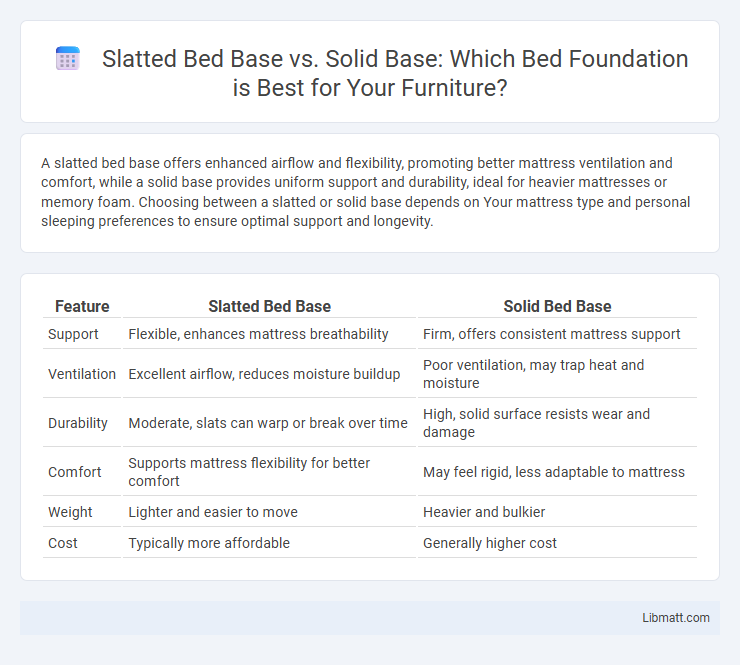A slatted bed base offers enhanced airflow and flexibility, promoting better mattress ventilation and comfort, while a solid base provides uniform support and durability, ideal for heavier mattresses or memory foam. Choosing between a slatted or solid base depends on Your mattress type and personal sleeping preferences to ensure optimal support and longevity.
Table of Comparison
| Feature | Slatted Bed Base | Solid Bed Base |
|---|---|---|
| Support | Flexible, enhances mattress breathability | Firm, offers consistent mattress support |
| Ventilation | Excellent airflow, reduces moisture buildup | Poor ventilation, may trap heat and moisture |
| Durability | Moderate, slats can warp or break over time | High, solid surface resists wear and damage |
| Comfort | Supports mattress flexibility for better comfort | May feel rigid, less adaptable to mattress |
| Weight | Lighter and easier to move | Heavier and bulkier |
| Cost | Typically more affordable | Generally higher cost |
Understanding Slatted Bed Bases
Slatted bed bases provide enhanced airflow and flexible support by using evenly spaced wooden or metal slats that adjust to body weight and movement, promoting better mattress longevity and comfort. Solid bases, while offering firm and uniform support, often limit ventilation, potentially causing moisture buildup and reducing mattress breathability. Understanding the benefits of slatted bed bases can help you optimize sleep quality by choosing a foundation that balances support and airflow for your mattress type.
What Is a Solid Bed Base?
A solid bed base consists of a continuous, flat surface typically made from plywood, MDF, or metal, providing uniform support across the entire mattress. It eliminates gaps and offers a firmer foundation, enhancing mattress durability and preventing sagging. Solid bases are ideal for memory foam or latex mattresses that require even pressure distribution for optimal comfort and longevity.
Key Differences: Slatted vs Solid Bed Bases
Slatted bed bases consist of multiple wooden or metal slats spaced evenly to provide flexibility and ventilation, improving mattress breathability and support. Solid bed bases feature a continuous platform, offering firmer and more stable support, ideal for memory foam or latex mattresses that require a flat surface. Your choice between slatted and solid bases affects mattress longevity, comfort, and airflow, making it essential to consider mattress type and personal sleep preferences.
Mattress Compatibility Considerations
Slatted bed bases offer enhanced breathability and flexibility, making them ideal for memory foam, latex, and hybrid mattresses that require airflow and adaptive support. Solid bases provide consistent firmness and stability, suitable for innerspring mattresses and those needing uniform support without gaps. Mattress compatibility largely depends on weight distribution, ventilation needs, and manufacturer recommendations to ensure optimal durability and comfort.
Comfort and Support Comparison
Slatted bed bases provide superior airflow and flexibility, enhancing mattress breathability and offering adaptive support that contours to your body shape, which can improve overall comfort. Solid bases deliver consistent, firm support that maintains mattress stability but may restrict ventilation, potentially affecting temperature regulation during sleep. Your choice depends on whether you prioritize responsive comfort with better airflow or the uniform support of a solid foundation for your mattress.
Durability and Longevity Factors
Slatted bed bases offer enhanced ventilation, reducing moisture buildup and extending mattress life, while their flexible slats absorb weight variations, preventing premature sagging. Solid bases provide consistent support and are often made from robust materials like plywood or MDF, which resist warping but may trap humidity, potentially affecting longevity. Choosing between the two depends on material quality, construction, and maintenance, all key factors influencing durability and overall lifespan.
Airflow and Hygiene Benefits
A slatted bed base provides superior airflow by allowing air to circulate freely around your mattress, reducing moisture buildup and preventing the growth of mold and dust mites. In contrast, a solid base restricts ventilation, which can trap humidity and create an environment conducive to allergens and bacteria. Choosing a slatted base supports better hygiene by keeping your sleeping area fresher and healthier over time.
Noise and Stability Issues
Slatted bed bases often generate noise due to individual slats flexing or rubbing against the frame, which can lead to creaking sounds over time, whereas solid bases provide a more stable and quiet sleeping surface with minimal movement. The stability of solid bases reduces the risk of frame wobbling or shifting, enhancing overall bed durability and support for various mattress types. In contrast, slatted bases may compromise stability if slats are spaced too far apart or made from lower-quality materials, potentially causing uneven mattress support and increased noise.
Price and Value Analysis
Slatted bed bases generally offer a more cost-effective solution, providing adequate support and breathability for mattresses at a lower price point than solid bases. Solid bed bases tend to be pricier due to their sturdier construction and enhanced durability, which can contribute to longer-term value despite the higher initial investment. Evaluating price against factors like mattress compatibility, ventilation, and lifespan helps determine the best value for individual sleep needs.
Choosing the Right Bed Base for Your Needs
A slatted bed base offers optimal airflow and flexibility, making it ideal for memory foam mattresses and improving overall mattress longevity. Solid bases provide sturdy, uniform support, best suited for heavier mattresses or those requiring firmer backing. Understanding your mattress type and personal comfort preferences helps you select the perfect bed base to ensure better sleep quality and support.
slatted bed base vs solid base Infographic

 libmatt.com
libmatt.com